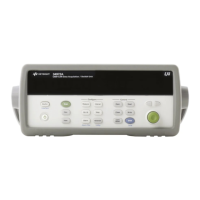Features and Functions 4
Keysight 34970A/34972A User’s Guide 159
Using alarms with the multifunction module
You can configure the instrument to generate an alarm when a specific bit pattern
or bit pattern change is detected on a digital input channel or when a specific
count is reached on a totalizer channel. These channels do not have to be part of
the scan list to generate an alarm. Alarms are evaluated continuously as soon as
you enable them.
– The digital input channels are numbered “s01” (lower byte) and “s02” (upper
byte), where s represents the slot number. The totalizer channel is numbered
“s03”.
– Alarms are evaluated continuously on the multifunction module, but alarm
data is stored in reading memory only during a scan.
– Each time you start a new scan, the instrument clears all readings (including
alarm data) stored in reading memory from the previous scan. However, alarm
data stored in the alarm queue from the multifunction module is not cleared.
Therefore, although the contents of reading memory are always from the most
recent scan, the alarm queue may contain data that occurred during previous
scans or while the instrument was not scanning.
– Front-Panel Operation: To configure an alarm on a digital input channel,
choose from the following items and then set the desired bit pattern. Set each
bit to “0”, “1”, or “X” (don’t care). You can either specify that an alarm will
occur when certain bits change or when a specific 8-bit pattern is read.
NOT PATTERN , PATTERN MATCH
To configure an alarm on a totalizer channel, select a high limit and then set
the desired count for the selected alarm.
HI ALARM ONLY
00X10010 BIN

